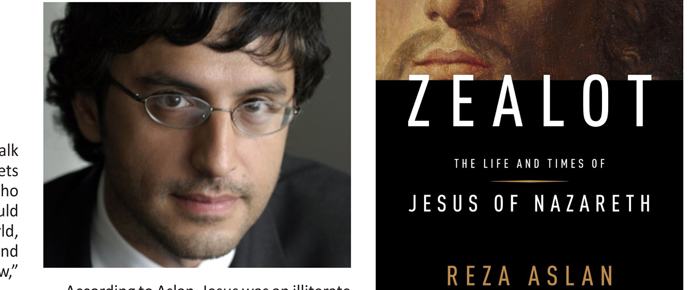
By Heidi Simmons
—–
Zealot: The Life and Times of Jesus of Nazareth
By Reza Aslan
Non fiction
—–
Jew or gentile, believer or non-believer, the life of Jesus has shaped our world. But how much do we really know about the man, his life, or his divinity? Would a better understanding of his history make a difference to us today? Reza Aslan’s bestseller Zealot: The Life and Times of Jesus of Nazareth (Random House, 297 pages) explores the historic evidence surrounding Jesus and the making of Christianity.
Aslan, a Muslim and historical scholar, is not constructing an argument for or against Jesus. Rather, it is his attempt to peel away the misconceptions, exaggerations and fabrications around the narrative of Jesus without embellishment, conjecture or an agenda.
The result of his research is simple and not too complicated: Jesus was a Jew, he was passionate about his Jewish beliefs, angry at Rome for the occupation of Palestine and frustrated with the high Priest’s control and exploitation of the Temple and Jewish people. He was a nationalist, a revolutionary, and a radical political leader who challenged the authorities for the position of king. He failed and was sentenced to death for sedition.
According to Aslan, Jesus was a zealot. “To be zealous for the Lord was to walk in the blazing footsteps of the prophets and heroes of old, men and women who tolerated no partner to God, who would bow to no king save the King of the World, and who dealt ruthlessly with idolatry and with those who transgressed God’s law,” writes Aslan.
Zeal was a philosophical movement different from the Pharisees, the Sadducees and the Essenes philosophy that included a strong commitment to freeing Israel from foreign rule and an insistence that they would serve no lord save the One God.
During Jesus’ life, zealotry was an idea, a model of piety. There was a sense of apocalyptic expectations that a new order would be revealed, and only those with zeal could bring it about. This according to Aslan, was the historic Jesus.
Aslan carefully constructs the history of the Jews from the rule of King David through the final destruction of Jerusalem in 70 C.E. Jesus is one of several who attempted to take over the kingdom and failed, says Aslan.
According to Aslan, Jesus was an illiterate peasant from a town so small and poor — Nazareth — it wasn’t on a map. However, Jesus emerges as a zealot ready to take on the fight against those who controlled and dominated Palestine and the Temple. After being baptized by John, Jesus gathers his disciples representing the twelve tribes and sets out on a death mission — knowing full-well the crimes he would be committing and the severity of the punishment. Jesus brazenly and carefully orchestrates his attacks on the Temple priests drawing the attention of the most powerful of the region.
Besides being a zealot, Jesus is a healer and a miracle worker drawing more people to his cause. According to Aslan, his healing of people was only used as a further attack on the Temple priests to undermine their control and power over the weak and poor. Aslan insists, Jesus claimed he was the “Son of Man” and his only goal was to establish the Kingdom of God on earth. And for this act of sedition and only sedition, he was captured and crucified.
This historical zealot, is not the New Testament Jesus of peace, compassion, mercy and forgiveness but an intolerant, ethnocentric, Torah-faithful, law abiding nationalist, prone to violence, whose charity was intended only for his fellow Jews.
After recounting the death of Jesus, Aslan makes his case for the Jesus we have today. The Jewish believers after Jesus’ death broke into two differing camps — the Hebrews and the Hellenists. The Hebrews were Jerusalem based Jews who were made up of peasants, fishermen and farmers but were unable to articulate and spread the message effectively.
The Hellenists were the Diaspora who spoke Greek, were educated and wealthier. They separated themselves from the Mosaic laws; shed the nationalistic concerns in order to make it more appealing to their fellow Greeks and Romans.
Years later, Saul of Tarsus, a Jewish bounty hunter chasing down Jewish agitators who embraced the message of Jesus, suddenly becomes a believer himself and is renamed Paul. It is Paul who labels Jesus “The Christ”. Insisting Jesus was much more than the “Son of Man.” He was divine. All this according to Aslan.
In 325 C.E., Rome’s Emperor Constantine accepted Christianity and wanted consensus on the life of Jesus. With this new doctrine, Jesus the Zealot no longer existed. His life and history was modified to fit a new agenda. Aslan concludes his book with: Jesus the Zealot “is every bit as compelling, charismatic and praiseworthy as Jesus the Christ.”
It’s fascinating to learn more about the life and times of Jesus and the rise of Christianity. But sadly, this book does not deliver a better understanding of the man Jesus. Nor does Aslan paint a clear picture of the zealot. If you do not know the New Testament Jesus’ — his words and actions — this book hardly makes sense. Aslan rarely gives examples of Jesus’ teaching whether zealot or peacemaker.
The zeal side of Jesus is an amazing quality that is certainly a part of who he was. However, I wonder if we were to follow that Jesus today, what would the world look like? Isn’t it zeal that has the Middle East in such conflict? Perhaps the less historical Jesus, that of Peacemaker is more relevant today?










































